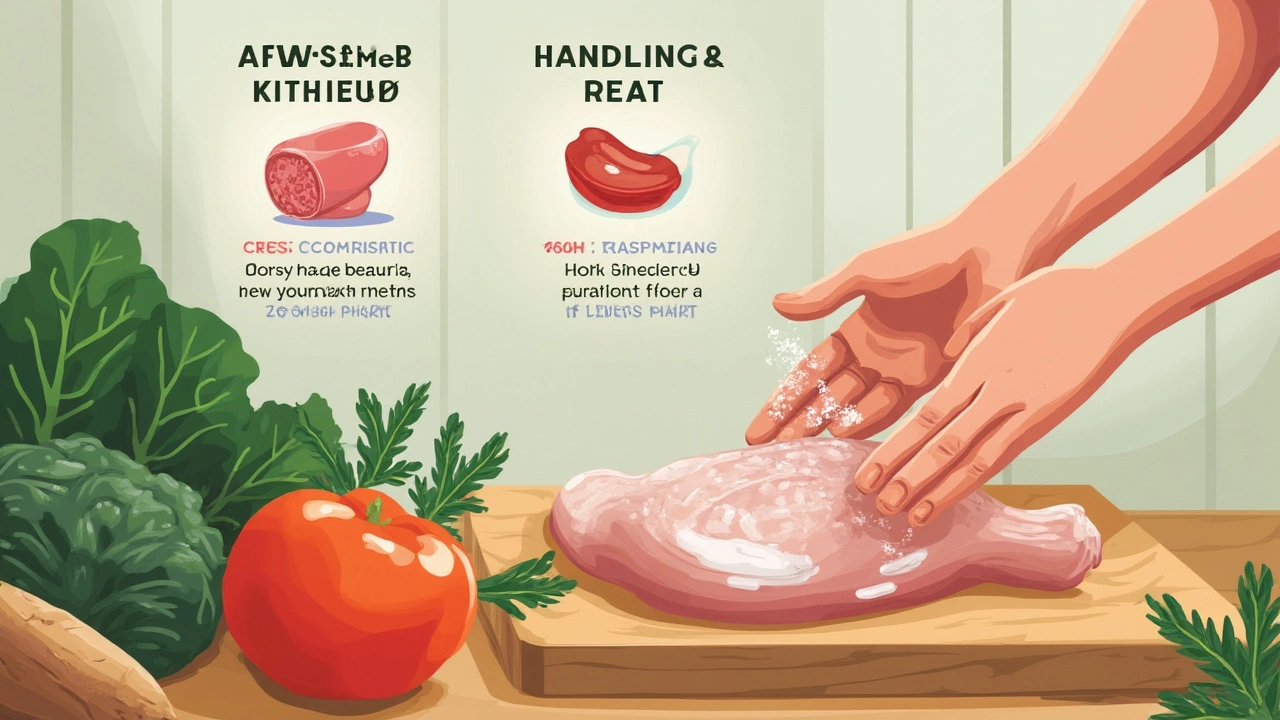You might guess cooking meat or chopping onions is the most dangerous part of food prep, but the real risk hides in a step most people ignore. The moment raw meat, cutting boards, and your hands all hang out together, the risk of cross-contamination skyrockets. This is when bacteria like salmonella or E. coli can leap from raw chicken to your salad without you even noticing.
Most kitchen slip-ups aren’t about burning the roast or overcooking pasta. The biggest mess-ups happen when bacteria jump from raw foods to ready-to-eat dishes. Glancing at your kitchen routine: ever cut raw chicken and then slice a cucumber without washing your board or knife? That's the classic move that causes stomach bugs. It can happen in seconds, and the results can send you running for the bathroom—or worse.
Knowing how germs travel in your kitchen is a total game changer. It’s not only about wiping counters; it’s about how often you wash your hands, swap cutting boards, and manage leftovers. These habits are what stand between ‘yum’ and ‘yuck’. We’ll unpack exactly which steps to watch most and how a couple small changes can save your gut—and your whole family—from a rough night.
- Where Kitchens Go Wrong: It’s Not What Most Think
- Why Cross-Contamination Is Public Enemy Number One
- The Sneaky Ways Germs Spread—Right Under Your Nose
- Who’s Most at Risk and Why It Matters
- Simple Tips to Dodge the Danger
- Everyday Fixes for Safer, Stress-Free Cooking
Where Kitchens Go Wrong: It’s Not What Most Think
Ask someone what they worry about in the kitchen, and you’ll usually hear about undercooked chicken or cuts from a sharp knife. But that’s not the biggest threat lurking by your stove. Kitchens turn risky the moment raw foods and ready-to-eat stuff share tools and surfaces. This is the silent part of food prep everyone underestimates.
It’s easy to picture germs jumping around when you see raw chicken juice drip on the counter, but the main riskiest food prep step is actually cross-contamination—when bacteria get comfy on hands, knives, cutting boards, and then end up on a sandwich, salad, or even your fridge handle.
"Most outbreaks of foodborne illness start in the home kitchen due to improper handling of raw foods and cross-contamination, not because of how well food is cooked." — Centers for Disease Control and Prevention
Let’s get specific. Take a look at the most common kitchen slip-ups that set you up for trouble:
- Chopping veggies after raw meat without cleaning your board and knife first
- Rinsing chicken in the sink, spraying bacteria up to three feet away
- Tasting food with the same spoon you used to stir raw ingredients
- Letting groceries sit out too long so bacteria multiply like crazy
If you think the problem is minor, check out these stats about home kitchen safety:
| Risk Factor | Percentage of Homes With Issues |
|---|---|
| Used same cutting board for raw meat & produce | 52% |
| Didn’t wash hands after handling raw meat | 27% |
| Didn’t clean counters after prepping raw meat | 41% |
These numbers aren’t just “bad habits”—they’re the reason food poisoning can happen at home more than you might think. Most people don’t realize that a simple oversight like skipping a hand wash is the first step toward trouble. The small stuff you skip when you’re in a rush? That’s what usually makes or breaks a safe meal.
Why Cross-Contamination Is Public Enemy Number One
Let’s be blunt. Cross-contamination is the easiest way for foodborne illnesses to crash your dinner. This happens when bacteria or other germs from raw foods (like chicken, beef, eggs, or even unwashed veggies) end up on foods that won’t get cooked again. Unlike some food mistakes, you can’t see it, smell it, or taste it—which makes it all the more risky.
The CDC reports that roughly 48 million Americans get sick from foodborne bugs every year—most traced back to simple mistakes in home kitchens. Cross-contamination is behind a huge chunk of those cases. One nasty culprit you hear about a lot? Campylobacter. It can survive on kitchen counters or utensils for hours. Even a small splash of raw chicken juice can spread millions of bacteria in seconds.
Here’s how germs usually leap from one spot to another:
- Using the same cutting board for raw meat and salad veggies
- Not washing hands between handling raw foods and ready-to-eat items
- Placing cooked food back onto a plate that held raw meat
- Forgetting to clean sinks, sponges, or countertops after prepping raw ingredients
Ready for some eye-openers? Take a look at how long some common germs hang around, and how many people get sick from the most common food culprits:
| Germ | How Long It Survives (on surfaces) | Estimated US Cases/Year |
|---|---|---|
| Salmonella | Up to 4 hours | ~1.35 million |
| Campylobacter | Up to 4 hours | ~1.5 million |
| E. coli | Up to 24 hours | ~265,000 |
| Norovirus | Days to weeks | ~21 million |
It doesn’t take much for these germs to end up on something you pop straight into your mouth, especially when you’re in a hurry or distracted. Most kitchen tools, like sponges and towels, are sneakily good at helping germs get comfortable and spread everywhere.
If you want to dodge the fallout, treat anything that’s touched raw meat or eggs like it’s radioactive. Wash hands with soap and water—hand sanitizer won't cut it on greasy meat hands. Get separate boards for meat and veggies. Clean as you go, and never let cooked food rest where raw lived. Small habits stack up to make your kitchen way, way safer.
The Sneaky Ways Germs Spread—Right Under Your Nose
Ever drop a chicken breast on the counter and wipe it up with the same sponge you use for everything else? That’s a classic way bacteria make the jump from raw food to the rest of your kitchen. The USDA found that nearly 97% of people don’t wash their hands correctly after handling raw meat. That one slip alone spreads germs to fridge handles, faucet knobs, and basically everything you touch next.
Cross-contamination doesn’t always look dirty. Let’s say you rinse veggies in the sink after tossing bits of raw ground beef down the drain. Bacteria can linger in the sink basin or even on the faucet handle, quietly catching a ride to other foods. Or picture using a cutting board for both chicken and onions; unless it’s washed with hot, soapy water in between, germs stick around and end up in your stir fry, raw in your sandwich, or on your next snack.
According to the Centers for Disease Control and Prevention, "Microscopic amounts of raw meat juice can transfer harmful bacteria to foods that won’t be cooked—even a little can make you sick."
Here are some everyday ways germs hitchhike around kitchens without you noticing:
- Reusing knives or cutting boards between raw meat and produce without washing.
- Touching spice jars or fridge handles with raw chicken juice still on your hands.
- Setting reusable grocery bags on the counter right after carrying uncooked meat in them.
- Using kitchen towels to dry hands that have wiped up raw egg or meat spills.
If you want to cut down your cross-contamination risk, start keeping a mental checklist. Wash your hands with soap and water for a full 20 seconds, change or disinfect sponges often, and use separate boards for veggies and meats. It only takes one shortcut for germs to beat you at your own meal prep game.

Who’s Most at Risk and Why It Matters
Some folks can eat a slightly undercooked burger and shrug it off, but others can land in the ER from the same meal. Babies, little kids under five, pregnant women, seniors over sixty-five, and anyone with a weak immune system (think: people going through chemo or living with diabetes or HIV) face way bigger risks from kitchen slip-ups. Their bodies just can’t fight off germs as fast as a healthy adult’s can.
Here’s a not-so-fun fact: Each year, about 48 million Americans get sick from foodborne bugs—of those, the hospitalizations and deaths hit the groups above way harder, according to the CDC. A simple mistake with raw chicken or dirty surfaces can mean a quick ER visit for grandma, but just mild stomach cramps for a college kid.
Messing up the riskiest food prep step doesn’t just mean “a 24-hour bug.” Some bacteria can lead to kidney failure or even death in vulnerable people. Listeria, for example, is especially rough on pregnant women and their babies. E. coli is notorious for turning a BBQ into a nightmare for toddlers and older adults.
- Kids: Their immune systems aren’t finished developing, so they get hit fast and hard.
- Pregnant women: Life-changing infections can cross over to the baby, sometimes before mom even feels sick.
- Seniors: Their bodies respond more slowly to germs, so infections get worse before they get better.
- People with ongoing health problems: Medications and long-term illnesses lower the body’s defenses.
If anyone in your house falls into these groups, pay extra attention when handling raw food, swapping cutting boards, or cleaning hands. Even if you bounce back easily, someone else might not be so lucky.
Simple Tips to Dodge the Danger
If you want to sidestep food poisoning, you’ve got to nail safe habits during meal prep. Knowing what actually works beats guessing. These tips zero in on the stuff that science backs and food safety experts swear by.
- Use separate cutting boards. Have one for raw meat, poultry, and seafood. Use another board for veggies, fruit, bread, or anything ready to eat. Don’t mix them up. A study by the USDA found nearly a third of people cross-contaminate by using the same board without proper cleaning.
- Always wash your hands for at least 20 seconds with soap and warm water after handling raw meat, eggs, or seafood. More than 50% of home cooks skip this, which is why germs end up where you least expect.
- Sanitize knives and utensils right after they touch raw protein. Hot, soapy water does the trick. Running them through the dishwasher? Even better.
- Keep raw meats on the bottom shelf in the fridge. This stops juices from dripping onto foods that won’t be cooked.
- Don’t rely on looks or smell to tell if meat is safe to eat. Use a food thermometer—165°F (74°C) for chicken, 160°F (71°C) for ground beef, 145°F (63°C) for whole cuts of beef or pork. It’s the only way to be sure.
- Wipe down counters and sinks with disinfectant after prepping raw meat. A quick rinse with water isn’t enough. Lots of bacteria can keep multiplying on a wet or dirty surface.
Check out how these habits cut down on risky outcomes:
| Bad Habit | Risk Level | Quick Fix |
|---|---|---|
| Cutting raw chicken and then salad veggies on same board | High | Use separate cutting boards or scrub with hot, soapy water between uses |
| Not washing hands after touching raw meat | High | Wash hands 20 seconds with soap and water |
| Leaving cooked food at room temp for hours | High (bacteria double every 20 mins at room temp) | Refrigerate leftovers within two hours |
Sounds simple, but these upgrades lower your risk of foodborne illness by over 85%. Keep these tips in your routine and you’ll dodge most of the trouble that trips up home cooks. Plus, you’ll keep that riskiest food prep step from making you sick.
Everyday Fixes for Safer, Stress-Free Cooking
If you want a kitchen that’s less risky, small changes can really lower your chances of getting sick. These fixes don’t need fancy stuff or tons of time—just a new routine and a bit more attention to what’s happening on your counter.
First things first, set up separate cutting boards for raw meat and produce. Color-coding helps; grab a red one for meat and a green one for veggies. This makes it almost impossible to mix them up in the heat of cooking. If you have a dishwasher, toss boards in after every use—high heat actually kills most bacteria.
When it comes to hand-washing, don’t wing it. Scrub with soap and water for at least 20 seconds. The CDC still says this is your top defense against germs. And use paper towels when you can—sponges and kitchen towels can hold onto bacteria for days, even if they look clean.
- Always use a food thermometer with meat. The USDA says chicken is safe at 165°F, and beef at 145°F—guessing just doesn’t cut it.
- Keep ready-to-eat foods far from raw stuff while prepping. If space is tight, prep veggies before you tackle the meat.
- Feel free to use kitchen timers so you don’t forget about perishables sitting out. Anything past two hours in the “danger zone” (40°F–140°F) is risky.
Need some numbers? Here’s how fast things can go wrong if you don’t follow basic riskiest food prep step fixes:
| Risky Practice | Illness Risk (Chance of Getting Sick) |
|---|---|
| Chopping veggies after raw chicken on same board | Up to 500x higher |
| Leaving cooked food out 3+ hours | Bacteria can double every 20min |
| Not washing hands after handling raw meat | Hands carry 200+ germs per square inch |
If you’re in a rush, stick to one rule: treat anything that touched raw meat like it’s covered in hot sauce. Clean it, switch it, or don’t use it again until you do. This one habit stops most foodborne germs in their tracks—no stress, no mess, just safe meals for everyone.





